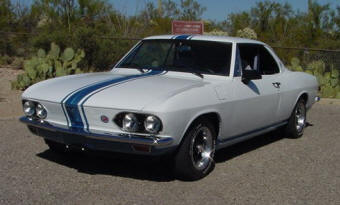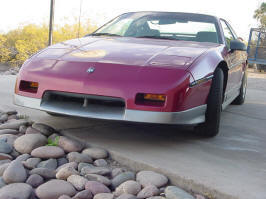
Corvair Tire Pressures
Response:
Weight distribution is just part of the picture. For a very good explanation
of this topic, Jim Hall wrote a couple articles (What Makes Cars Handle? parts I and II - see links below) in Car and Driver magazine in April and May 1965 you might be able to
unearth. Jim Hall was the smart guy out of Midland, Texas who built the
Chaparral race cars.
All tires have a slip angle when they're turning corners, thereís a
difference between the actual path they take and the exact angle they're
being steered, the wider path taken by the tire is determined by the
additional 'slip' and the difference between the two is slip angle. Slip
angles are carefully controlled on cars because its important they're very
similar on both ends of the car, a slightly larger slip angle on the back
will turn in to ferocious oversteer at speed and a small amount of extra
slip on the front deteriorates into extreme plowing understeer at high
speed. The ideal is to minimize slip generally, and maintain a slightly
greater amount of front slip under most circumstances so that the driver has
the option of modulating slip angles himself with the throttle. Because at
high speeds the car is traveling hundreds of feet per second small changes
make gigantic differences to what side of the road you end up on and which
way you're facing that wouldnít be an issue at modest speeds.
Tire slip angles are determined by the load carrying abilities of the tire
compared with the load they are seeing at a given moment and job they're
being asked to do. Bigger tires or more air pressure reduce slip angles and
smaller tires or lower air pressure increase slip angles. The more weight or
cornering, acceleration and braking loads you're expecting a tire to carry,
the greater its slip angles. In a car with a lot of weight at one end you
have some options for reducing the slip angle of the tires on the 'heavy'
end: larger tires and/or higher tire pressure and/or reducing roll
stiffness. Roll stiffness is the resistance of the car body to lean in
corners. Suspensions can be designed to not resist or strongly resist the
effect of the body lean in corners. Adding roll stiffness (resistance to
leaning) increases slip angles on the end of the car thatís resisting the
roll. Because roll is proportional to cornering forces this allows the
suspension engineers to tune the chassis to make the most of the cornering
power at both ends of the car by progressively shifting loads in corners to
the end of the car with the smallest slip angles; the roll is carried on the
end that has extra traction. The effect of resisting the body lean by a
stiff spring or sway bar is that the tire on the outside of the turn carries
an ever-increasing share of the load, which increases its slip angle, and
promotes neutral handling.
GM got their fingers burned bad enough on the Corvair viz tire pressure
differentials that I would imagine they were loathe to suggest staggered
tire pressures on the Fiero. So, they found other ways to equalize the slip
angles on the Fiero, namely putting most of the roll stiffness in the front
suspension to force it to carry roll loads and generate higher slip angles
when the car was pushed in corners to make sure the tail didnít get away.
The early Corvair has tremendous rear roll stiffness and swing axles donít
let you reduce it much, even with softer springs and considerably increased
front roll stiffness, so tire pressures were pretty nearly the only tool
that would really make a difference on earlies - the lates have very weak
rear roll stiffness and this is mostly why they are inherently better
handling cars. Most efforts to tame the Corvair are focused on increasing
front roll stiffness to transfer cornering loads onto the front wheels to
minimize the possibility the rear will generate larger slip angles than the
front.
GM makes a few other vehicles with very similar weight distribution to the
Corvair that are generally regarded as safe and not inherent oversteering
machines - the small block Corvette for many years was pretty close to the
Corvair weight distribution, most full sized station wagons also are, and
any moderately loaded pickup truck is. The 1971-1976 GM B body station
wagons have virtually identical suspension geometry to the late Corvair
despite a very different looking suspension (leaf springs in the back). Itís
designed to minimize roll resistance and transfer loads to the front wheels
in cornering, and has about the same roll axis as the 1965 Corvair.
I would encourage you to track down Jim Hall's article if you can
find it, I imagine someone on VV might be able to scan you a copy, for a
fuller understanding of the subject.
Hope that was some help,
Brent Covey
Vancouver BC
Print the above response: PDF format
Read the article by Jim Hall
What Makes Cars Handle? Part I and
What Makes Cars Handle? Part II

